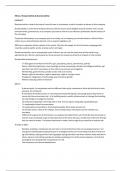Ethics, Responsibility & Sustainability
Lecture 1
Business ethics: what is the value I want to have in a business; code of conduct w values of the company
Sustainability: comes from forestry (when you fell a tree you were obliged to plant another one); social,
environmental, governance; as a company you have a role to try to influence politicians abt the values of
the company
Corporate citizenship: as a company you’re an entity; as a company you should behave a little bit like a
citizen so you should behave decent; act as a good neighbour etc
SDGs are created by all the nations of the world; 70y from the target; for the first time a language that
could be used by public sector, private sector and ngos
Planet boundaries: we’ve overpassed some of them; we can use the resources of the earth for eg
agriculture etc; there’s a safe place but if we overuse the resources there’s an impact on the climate
Sustainable development:
- 17 SDG goals are linked to the 5P’s (ppl, prosperity, peace, partnership, planet)
- Peace: effective diplomacy, must leverage to stop unnecessary border and religious battles; ppl
say that if we don’t have peace in the nations we cannot work together
- Partnership: governments, private sector and civil society
- People: right to education, right to equal pay, right to a proper meal
- Prosperity: integration of technology and economic growth
- Planet: reducing carbon emissions
SDG’s:
- 8 decent work: for employees can be different than eg for contractors; think abt the kind of work
you give, the timing etc
- 9 innovation & infrastructure: is it necessary to keep the big HQ, encourage ppl to stay home or
come into the environment etc ; if in building sector: public infrastructure to change the building,
try new things to change the field etc
- 10 reduced inequalities: think abt who to hire, how to reduce inequality, eg disabled ppl
- 11 sustainable cities & communities
- 12 responsible consumption: food of good quality, fresh water access etc
- 13 climate action: what is the impact, how to help reduce the impact on the climate as a
company
- Difficult to be good on all the factors, you always have dilemma’s; you think abt security of ppl so
need to scan everybody to go on the plane but at the same time you create loss of time for the ppl
bcs you need to make -> business decisions to make, which sdgs do you decide to improve etc
Threats to SDG:
- Rainbow washing: companies rely not only on environment but also on social governance; not
only green washing (aka saying that you’re ecological when you’re not really) but also in terms of
eg child labour, paying workers well (eg apple saying that they treat their workers really well but in
china, ppl are committing suicide) so rainbow washing is for all the social aspects, not only the
ecological ones (saying that it’s good but it’s not)
- The resistance of internal stakeholders
, Lecture 2
From CSR mgt to stakeholder theory
Pyramid of CSR (Carroll, 1991)
- Philanthropic: desired; different from sustainability, companies can
do philanthropy on top of everything else but it doesn’t mean that
their underlying is sustainable; be a good corporate citizen
- Ethical: expected; be ethical
- Legal: required; obey the law
- Economic: required; be profitable
Strengths: widely cited; leading paradigm in CSR
Weaknesses: use of pyramid to depict relationships; role of philanthropy as a separate component;
incomplete theoretical development of economic, legal and ethical domains
Three-domain model of CST (Schwartz & Carroll, 2003)
- Economic: activities w direct or indirect
positive economic impact on the corporation
- Legal: firm’s responsiveness to legal
expectations of society, relating to
compliance, avoidance of civil
litigation/anticipation of law
- Ethical: ethical responsibilities as expected by
general population & stakeholders
As a company, you try to go to the middle of the model;
try to get to a decision that reaches all three of the
targets at the same time
Strengths: venn diagram to reflect overlapping nature of CSR domains; philanthropy encompassed within
economic/ethical dimension; theoretically develops the economic, legal and ethical domains; focuses on
forces that come into play during ethical decision making
Weaknesses: assumes the three domains of CSR as distinct and all-encompassing; complications of intl
business confound ethical/legal domains; certain CSR categories will rarely apply – limiting practical and
conceptual application of some segments of the model
Stakeholder theory
How to translate the ‘social’ in CSR into an object of managerial attention and action?
- Critical in today’s management
- Realistic picture of business world
- New role for mgt: agents of shareholder; think in a much broader way than in the past
- New approach to corporate governance: stakeholders hold a legitimate interest; a higher/lesser
stake in corporate activity
Case 1: The Brent Spar disposal
Brent spar is an oil platform in the north sea; contains storage tanks; commissioned = end of its useful
life; the ppl never had thought of the end of life, they built sth and didn’t think abt what would happen at
the end of the life
- Plan to let it sink was approved by the British govn bcs it was the most economical plan
- Greenpeace rejected the scientific conclusion; actions against it




